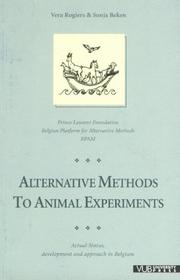| Listing 1 - 4 of 4 |
Sort by
|
Book
ISBN: 149392074X 1493920731 Year: 2015 Publisher: New York, NY : Springer New York : Imprint: Humana,
Abstract | Keywords | Export | Availability | Bookmark
 Loading...
Loading...Choose an application
- Reference Manager
- EndNote
- RefWorks (Direct export to RefWorks)
This volume presents 30 state-of-the-art protocols and reviews to set up and apply primary hepatocyte cultures for research and screening purposes. The first part of the book focuses on the use of these particular liver-based in vitro models to study the different aspects of the hepatocyte life cycle, including cell growth, differentiation and cell death. The second part of the book is targeted towards the demonstration of the applicability of primary hepatocyte cultures, or liver-based in vitro models derived thereof, for functionality and toxicity testing. Written in the highly successful Methods in Molecular Biology series format, chapters include introductions to their respective topics, lists of the necessary materials and reagents, step-by-step and readily reproducible laboratory protocols, and key tips on troubleshooting and avoiding known pitfalls. Authoritative and practical, Protocols In In-Vitro Hepatocyte Research is intended for basic and applied researchers in the area of pharmacology and toxicology, both in academic and industrial settings. .
Toxicology. --- Pharmacology/Toxicology. --- Chemicals --- Medicine --- Pharmacology --- Poisoning --- Poisons --- Toxicology

ISBN: 9054872640 Year: 2000 Publisher: Brussel VUB University Press
Abstract | Keywords | Export | Availability | Bookmark
 Loading...
Loading...Choose an application
- Reference Manager
- EndNote
- RefWorks (Direct export to RefWorks)
Animal welfare. --- Dierproef --- Dierenwelzijn --- Expérimentation animale --- Bien-être des animaux --- Toxicologie --- Dierproeven
Dissertation

Year: 2007 Publisher: Leuven K.U.Leuven. Faculteit Farmaceutische wetenschappen
Abstract | Keywords | Export | Availability | Bookmark
 Loading...
Loading...Choose an application
- Reference Manager
- EndNote
- RefWorks (Direct export to RefWorks)
Dissertation
Year: 2024 Publisher: Leuven KU Leuven. Faculteit Industriële Ingenieurswetenschappen
Abstract | Keywords | Export | Availability | Bookmark
 Loading...
Loading...Choose an application
- Reference Manager
- EndNote
- RefWorks (Direct export to RefWorks)
The 3Rs principle (Replacement, Reduction, Refinement) was introduced into the European Legislation by Directive 2010/63/EU to protect experimental animals. The European cosmetic industry was directly affected as cosmetics, and their ingredients were entirely taken up in the Cosmetic Regulation (CR). As an immediate consequence, risk assessment to show the safety of cosmetic products on the EU market was, from 2013 onwards, to be done without using experimental animals. Instead, alternative methods or the so-called New Approach Methodology (NAM), including in chemico, in silico, in vitro and ex vivo methods, and new technology, were to be used. Validated NAMs for local toxicity are available and regulatory-wise accepted. However, for systemic toxicity, this is not the case. As systemic toxicity is key in the risk assessment process, a worldwide initiative was taken to set up a new framework for systemic toxicity without animal use, the so-called Next Generation Risk Assessment (NGRA). The European Commission recently introduced the ‘Green Deal’ to protect our environment. One of the many measures is to ban hazardous chemicals such as endocrine disruptors (EDs) that may interfere with the hormonal system and harm humans and wildlife. This piece of EU legislation will also seriously affect the cosmetic industry. Until now, EDs were not regulated. This will directly change, and at the EU level, a priority list of 28 cosmetic substances with potential ED properties was composed for which risk assessment without experimental animal use is needed. The goal is to perform a case study for Genistein (on the ED list), tackle the risk assessment according to CR and NGRA methodologies, and discuss both assessments. The first approach consists of a general CR-driven risk assessment of Genistein based on principles and practices universally applied to chemical substances. After reviewing the available literature, exposure and hazard assessments are carried out, followed by risk characterisation. The second (new) approach consists of risk assessment according to the 9 principle NGRA framework, using different NAMs without animal data. It is a stepwise and hypothesis-driven assessment based on Physiologically Based Pharmacokinetic (PBPK) modelling and in silico and in vitro bioactivity assays. Guidelines for both assessments are in the ‘Notes of Guidance for the Testing of Cosmetic Ingredients and their Safety Evaluation’ of the Scientific Committee on Consumer Safety. A concentration of 0.007% Genistein in a body lotion was considered in both risk assessments. Genistein was chosen because of its potential endocrine-disrupting properties on the female reproductive and development system. The third and final part is a critical and qualitative analysis of both risk assessments by discussing the safety decisions, getting levels of confidence and (un)certainty of the evidence, positive and negative aspects of both assessments and potential ways to refine the NGRA methodology. As a final conclusion, we found that the NGRA methodology showed similar confidence, but higher uncertainty levels compared to the parameters tested for CR-driven risk assessment. This may change considerably in the near future when more experience with the new methodology becomes available. Combining both approaches, considering the positive aspects of both methods and refining the negative points of the NGRA could result in more accurate and trustful safety evaluations.
| Listing 1 - 4 of 4 |
Sort by
|

 Search
Search Feedback
Feedback About UniCat
About UniCat  Help
Help News
News